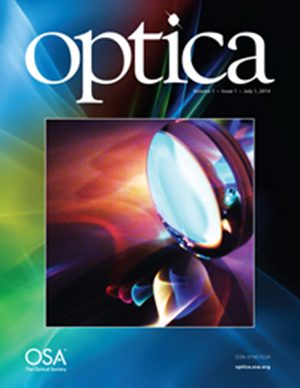High-efficiency high-numerical-aperture metalens designed by maximizing the efficiency limit
IF 8.5
1区 物理与天体物理
Q1 OPTICS
引用次数: 0
Abstract
Theoretical bounds are commonly used to assess the limitations of photonic design. Here we introduce a more active way to use theoretical bounds, integrating them into part of the design process and identifying optimal system parameters that maximize the efficiency limit itself. As an example, we consider wide-field-of-view high-numerical-aperture metalenses, which can be used for high-resolution imaging in microscopy and endoscopy, but no existing design has achieved a high efficiency. By choosing aperture sizes to maximize an efficiency bound, setting the thickness according to a thickness bound, and then performing inverse design, we come up with high-numerical-aperture (NA=0.9) metalens designs with, to our knowledge, record-high 98% transmission efficiency and 92% Strehl ratio across all incident angles within a 60° field of view, reaching the maximized bound. This maximizing-efficiency-limit approach applies to any multi-channel system and can help a wide range of optical devices reach their highest possible performance.最大限度提高效率极限而设计的高效率高数值孔径金属透镜
理论界限通常用于评估光子设计的局限性。在此,我们介绍一种更积极的方法来使用理论边界,将其融入部分设计流程,并确定能最大限度提高效率极限的最佳系统参数。例如,我们考虑了宽视场高数值孔径金属透镜,这种透镜可用于显微镜和内窥镜中的高分辨率成像,但现有的设计都没有达到很高的效率。通过选择孔径大小以最大化效率边界,根据厚度边界设置厚度,然后进行反向设计,我们设计出了高数值孔径(NA=0.9{\rm NA} = {0.9})金属透镜,据我们所知,在 60° 视场内的所有入射角,其传输效率和施特莱尔比分别达到了创纪录的 98% 和 92%,达到了最大化边界。这种最大化效率极限的方法适用于任何多通道系统,可以帮助各种光学设备达到尽可能高的性能。
本文章由计算机程序翻译,如有差异,请以英文原文为准。
求助全文
约1分钟内获得全文
求助全文
来源期刊

Optica
OPTICS-
CiteScore
19.70
自引率
2.90%
发文量
191
审稿时长
2 months
期刊介绍:
Optica is an open access, online-only journal published monthly by Optica Publishing Group. It is dedicated to the rapid dissemination of high-impact peer-reviewed research in the field of optics and photonics. The journal provides a forum for theoretical or experimental, fundamental or applied research to be swiftly accessed by the international community. Optica is abstracted and indexed in Chemical Abstracts Service, Current Contents/Physical, Chemical & Earth Sciences, and Science Citation Index Expanded.
 求助内容:
求助内容: 应助结果提醒方式:
应助结果提醒方式:


